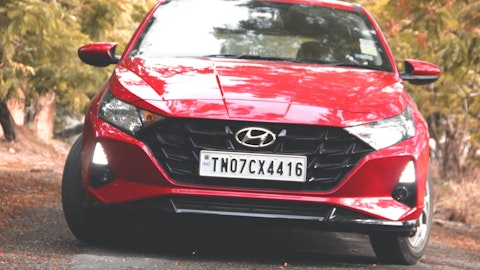Magna International Inc. (NYSE:MGA) Q3 2023 Earnings Call Transcript November 3, 2023
Operator: Greetings and welcome to the Q3 2023 results. During the presentation, all participants will be in a listen-only mode. Afterwards, we will conduct a question and answer session. At that time, if you have a question, please press the one followed by the four on your telephone. If at any time during the conference, you need to reach an operator, you may press the star, followed by the zero. As a reminder, this conference is being recorded Friday, November 3, 2023. I would now like to turn the conference over to Louis Tonelli, Vice President, Investor Relations. Please go ahead.
Louis Tonelli: Thanks Tommy. Hello everyone and welcome to our conference call covering our third quarter of 2023. Joining me today are Swamy Kotagiri and Pat McCann. Yesterday, our board of directors met and approved our financial results for the third quarter of ’23 as well as our updated ’23 outlook. We issued a press release this morning outlining our results. You’ll find the press release, today’s conference call webcast, the slide presentation to go along with the call, and our updated quarterly financial review all in the Investor Relations section of our website at magna.com. Before we get started, just as a reminder, the discussion today may contain forward-looking information or forward-looking statements within the meaning of applicable securities legislation Such statements involve certain risks, assumptions and uncertainties which may cause the company’s actual or future results and performance to be materially different from those expressed or implied in these statements.
Please refer to today’s press release for a complete description of our Safe Harbor disclaimer. Please also refer to our reminder slide included in the presentation that relates to our commentary today. With that, I’ll pass it over to Swamy.
Swamy Kotagiri: Thank you Louis. Good morning everyone. I appreciate you all joining our call today as we share our third quarter earnings results. Before I share some of the details, I want to thank my team for their continued progress and solid results, so let’s get started. Some key highlights to mention before I dive into the details. Our organic sales grew by 10% year-over-year, surpassing weighted production by 4% excluding complete vehicles and 2% including complete vehicles. Our third quarter showcased strong operating performance with higher organic sales once again contributing to robust earnings that represented a significant improvement year-over-year. We continue to benefit from our activities in operational excellence and cost containment, leading to improved margins.
We have raised our 2023 adjusted EBIT margin and adjusted net income outlook ranges for 2023, demonstrating solid operating performance even with the negative impact of the UAW strike in the third and fourth quarters, and recently announced our commitment to achieving net zero across Magna by 2050. Our industry continues to experience incremental improvements, including renewed supply constraints, stronger and more stable production schedules, and resilient auto sales in a number of markets. However, the global economy continues to face some interlocking challenges, including continuing elevated labor inflation, higher interest rates, geopolitical risks, and slowing economic growth. These challenges are impacting our entire industry. In North America, the Detroit 3 experienced UAW labor stoppages for about six weeks, which cost the industry approximately 220,000 units.
The UAW has now reached tentative agreements with all three OEMs which need to be ratified. Our outlook reflects the full extent of the strike. We remain highly focused on containing costs and improving our margins. This is being achieved through ongoing operational improvement and cost recovery initiatives, as well as executing flawless launches across Magna. At our virtual investor event in September, we provided an update on the progress of our go forward strategy. Our ongoing investments in mega-trend areas are driving significant growth over the coming years, including 35%-plus in power train electrification, 75%-plus in battery enclosures, and 45%-plus in active safety. Most importantly, our portfolio is substantially aligned with the car of the future, which we expect to drive sales growth regardless of the pace of powertrain electrification.
Where possible, we are working to mitigate risks, including by installing capital in tranches and employing different cost sharing models with our customers. At the same time, we have been accelerating our activities around operational excellence to ensure we remain at the forefront of manufacturing and exceeding our customers’ expectations in all areas. We expect about 150 basis points of margin expansion from our collective efforts here, including about half that amount this year, and we are leveraging capabilities that already exist within Magna to unlock opportunities with new models and markets as they develop. It is early days for us in this area, but we have already had some traction. We have experienced 5x growth in battery swaps in our battery-as-a-service venture and are experiencing about 1,000 deliveries a day utilizing Magna-produced parts.
We expect about $300 million in new mobility sales by 2027 with significant runway for additional profitable growth beyond that. We expect our strategy to deliver continued growth above market, improve margins and returns, and further shift in our portfolio towards mega-trend areas. This should drive increased shareholder value in the years to come. We also took a significant step forward in our commitment to sustainability and environmental stewardship by submitting net zero emission targets for validation by the Science Based Targets initiative with a goal to achieve net zero by 2050, together with meeting our near term Scope 1, 2 and 3 targets by 2030. Among the steps involved in meeting this target is transitioning to 100% renewable electricity use in our European operations by 2025 and globally by 2030.
They have already made progress towards previously established sustainability actions. This year, we are on track to achieve our commitment to reduce global energy intensity by 10% in all manufacturing facilities with a target of 20% reduction by 2027. More than 30 Magna divisions have achieved carbon neutrality over the last two years. With that, I’ll pass the call over to Pat.

Patrick McCann: Thanks Swamy, and good morning everyone. As Swamy indicated, once again we delivered strong earnings this past quarter despite the onsite of the UAW strike in September. Comparing the third quarter of 2023 to ’22, consolidated sales were $10.7 billion, up 15% compared to a 4% increase in global light vehicle production. Adjusted EBIT was $615 million and adjusted EBIT margin increased 90 basis points to 5.8%. Adjusted EPS came in at $1.46, up 33% year-over-year, and free cash flow generated in the quarter was $23 million compared to a $210 million use in the third quarter of ’22, despite our higher capital spend this quarter to support record program awards in ’22. During the quarter, we paid dividends of $128 million and we increased our adjusted EBIT margin and earnings outlook despite the negative impact of the UAW strike.
Let me take you through some of the details. North American and European light vehicle production were up 7% and 14% respectively, while Chinese production declined 2%, netting to a 4% increase in global production. Our consolidated sales were $10.7 billion, up 15% over the third quarter of ’22. On an organic basis, our sales also increased 10% year-over-year for a 2% growth over market, or 4% growth over market excluding complete vehicles. The sales increase was primarily due to higher global vehicle production, the launch of new programs, adjustments to recover certain higher input cost, the acquisition of Veoneer Active Safety net of the divestiture of our manual transmissions plant in Europe, and the net strengthening of currencies against the U.S. dollar.
These were partially offset by lower complete vehicle sales mainly due to a program changeover and an estimated $55 million impact from the UAW strike. Adjusted EBIT was $615 million and adjusted EBIT margin was 5.8% compared to 4.9% in the third quarter of ’22. Our continued focus on operational excellence and performance on cost initiatives is driving strong earnings on higher sales. This was despite the negative impacts of a program changeover in complete vehicles, the UAW strike which we estimate cost us about 10 basis points, and acquisitions net of divestitures. Combined, we generated 40 basis points of net improvements. Adjusted EBIT margin was also positively impacted by about 60 basis points of net operational items, which include productivity and efficiency improvements at certain facilities and lower net engineering costs, about 50 basis points related to lower net input costs, and higher equity income which benefited margin by about 15 basis points.
EBIT margin was negatively impacted by commercial items that had a net unfavorable impact in the quarter, which subtracted about 75 basis points year-over-year. Interest expense increased, primarily reflecting senior notes issued and borrowings in the first half of the year, as well as higher interest rates. Our adjusted effective income tax rate came in at 21.9%, largely in line with our ’23 expectations but lower than Q3 of last year. Adjusted net income attributable to Magna was $419 million, up 32% over the third quarter of ’22, reflecting higher EBIT and the lower tax rate partially offset by higher interest expense and minority interest. Adjusted diluted EPS was $1.46, up 33% compared to Q3 last year. This increase is the result of higher net income and fewer shares outstanding.
The reduced number of shares outstanding substantially reflects the impact of share repurchases in 2022. Turning to a review of our cash flows and investment activities, in the third quarter of ’23, we generated $821 million in cash from operations before changes in working capital, up $230 million or 39% from ’22, and we invested $24 million in working capital. Investment activities in the quarter included $630 million for fixed assets and $176 million for investments, other assets and intangibles. As expected, capex was higher than the $364 million in Q3 last year to support our record program awards in 2022. Overall, we generated free cash flow of $23 million in the third quarter. We also paid $128 million in dividends. Our balance sheet continued to be strong with investment-grade ratings from the major credit agencies.
At the end of Q3, we had over $4.5 billion in liquidity, including about a billion dollars of cash. Currently, our adjusted debt to adjusted EBITDA ratio is 2.02. Excluding cash we are holding to help pay down our €550 million senior notes coming due in the fourth quarter, our ratio would be 1.98. This ratio continues to decline and is tracking better than expected at the end of last quarter as a result of our improved operating results. We anticipate a reduction of our leverage ratio by the end of this year and a further decline through 2024. Next I will cover our updated outlook, which incorporates higher than previously expected vehicle production in both Europe and China, including as a result of better production in Q3. Our assumption for production in North America is unchanged from our previous outlook as stronger than expected production was offset by the impact of the UAW strike.
We have not assumed any lost D3 production is made up in the fourth quarter. We also assume exchange rates in our outlook will approximate current rates. We now expect a slightly weaker euro, Canadian dollar, and renminbi for 2023 relative to our previous outlook. We have narrowed our expected sales range with essentially the same midpoint as our last outlook. This mainly reflects higher European and Chinese vehicle production in the second half of ’23, offset by the much stronger U.S. dollar relative to our last outlook and the estimated $310 million impact of the UAW strike. We communicated last quarter that beginning in Q3, Magna’s adjusted EBIT would exclude the amortization of all acquired intangibles. Our August outlook excluded our estimate of the amortization of intangibles associated with the acquisition of Veoneer Active Safety, about $30 million for half of ’23.
Our final analysis of all other acquisitions resulted in about $50 million of additional annual amortization to be excluded from our adjusted EBIT calculation. This additional adjustment amounts to approximately 10 basis points in EBIT margin. We have updated our historical presentation of adjusted EBIT to reflect these revised calculations. As a result of our strong performance so far in ’23, our expectations for continued operational execution, and despite the negative impact of the UAW strike which we estimate to be between 10 and 15 basis points, we have narrowed and raised our adjusted EBIT margin. We now expect our EBIT margin for ’23 to be in the range of 5.1% to 5.4%, which compares to 4.9% to 5.3% previously, adjusted by the 10 basis points to reflect the amortization of all acquired intangibles.
We are increasing our equity income range, mainly reflecting our better than forecasted performance in Q3. As a result of increasing our adjusted EBIT margin range, we are also raising our range for adjusted net income attributable to Magna. Our interest expense, tax rate, capital spending and free cash flow expectations are all unchanged from our last outlook. In summary, we are pleased with our strong operating performance in third quarter. Once again, we outgrew our end markets by 2% on a consolidated basis and 4% excluding complete vehicles. We’ve raised our outlook for 2023 and we have continued confidence in our plans for margin expansion in the years to come. Thank you for your attention. We will be happy to answer your questions.
See also 10 Best Performing Technology ETFs in 2023 and 16 Highest Paying Countries for Project Managers.
Q&A Session
Follow Magna International Inc (NYSE:MGA)
Follow Magna International Inc (NYSE:MGA)
Operator: Thank you. [Operator instructions] Our first question on the line is from Chris McNally with Evercore. Please go right ahead.
Chris McNally: Thanks so much, team. Appreciate all the detail. Maybe we could start with the–you know, obviously the big topic of the week is around EV demand, and maybe you could just kind of level-set–you know, just remind us of your exposure particularly in powertrain, you have $800 million in last year, growing to, I think it’s about a billion this year. You have targets of, I think, $4 billion in the out years. What percentage is maybe pure EV versus [indiscernible] and hybrid – that would be helpful, and then just a pace on battery enclosures, which is obviously a new growth area. Just anything around ’23, ’24 – again, you’ve given longer term targets, and just remind us maybe some of the programs or geographic exposure. Those are the big questions, I think that you’ll probably get several times in the queue from the rest of the analysts, and maybe we can start there.
Swamy Kotagiri: Hi Chris, good morning. We will try to address the different aspects of the questions. I think from an EV perspective, just generally to address macro, we have always said electrification is a secular, irreversible trend and it’s here to stay, but the question was going to be the predictability of the take rates, how soon is it going to come, so it’s basically a very long tail and it’s still very early days of electrification. Also if you look at the last three or four years as we talked about electrification, we have generally said the global penetration will be somewhere in the mid-30s in percentage by 2030. Given those circumstances, our policy or our [indiscernible] has been to look at the volumes by program, by customer, look at external sources – IHS and our own internal volume predictions, and have been using that to come up with the numbers that you talked about.
In the past, not just related to EV, the volume uncertainty has been there on every program if you go back a few decades, and we have a mechanism to go through that in our planning process and how we put the capital forward, how we plan scalability and modularity, but beyond that even have the discussions with the customers when there is a significant change in volumes. But all that said, and a few questions specifically that you asked about, in electrification of powertrain specifically, we talked about $3 billion in 2025 managed sales and about $4 billion during our investor day in 2027. When we talk about those numbers, we have always taken into account the mechanism that I talked about of coming up with our own volumes, looking at multiple sources, looking at the take rates, which I would say are a little bit more conservative than what the customers in the markets have been talking, right, so that’s one piece.
On the battery enclosure side, I think, Louis, we are in the $300 million, $400 million this year–
Louis Tonelli: Yes.
Swamy Kotagiri: –and we were talking about $1.6 billion by 2025, and there we talked about the product line where we are using existing assets, whether it’s castings or exclusions or stampings, [indiscernible] and so on, and the dedicated assembly lines are considered tooling which is paid by the customer, right, so that continues, and that is also a strategic product in the sense that when you look at the frames and the underbody and so on, we see a path going forward, and we talked about the analogy to the frames in the past, where we did in the late 90s, and we continue to do the third and fourth generation of the same product today, so this is a long term play and we feel pretty good about that. I know I tried to address different aspects of the question. Did I miss anything there?
Patrick McCann: And the 48 volt is just under a quarter of our sales in ’27, of that managed sales number.
Chris McNally: And then what about plug-in as well, because obviously there is definitely more of a concern about pure EV than plug-in has sort of continued. There is a decent amount of PHEV, right, in your high voltage for powertrain as well?




